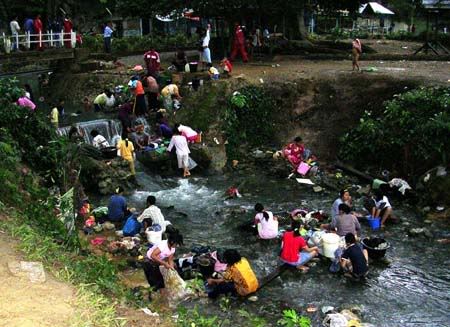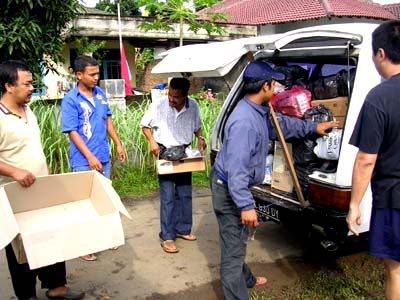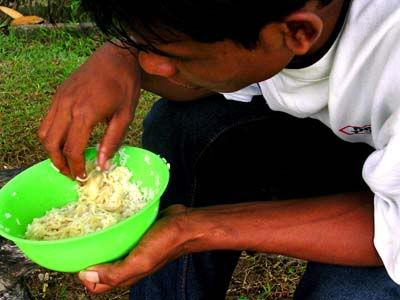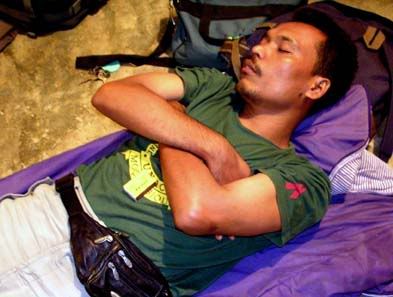Report From Medan - Aceh (January 5th 2005)
BY TAN JO HANN
This report is from the SEAPCP-KOMAS Emergency Mission (ERM) Team covering the first 2 days in Sumatra
KOMAS organized an all-Malaysian SEAPCP-KOMAS team. They are:
1. Mr. Tan Jo Hann (SEAPCP, Ground Operations Organizer)
2. Mr. Arul Prakkash (KOMAS, Video documenter)
3. Mr. Arumugam Marimithu (PERMAS, Ground Operations Organizer)
4. Ms. Cheam Swee Mui (individual, Paramedic)
5. Dr Tan Joe Ann (Doctor)
6. Dr Santhani M. Selvenidran (Doctor)
SEAPCP Team members from other parts of
7. Mr. Don Marut (INSISTS, Yogjakarta)
8. Mr.Nus Ukru (BAILEO, Maluku)
9. Mr. Effendi (LPTP, Solo)

Day 1 (January 5, 2005)
The team faced some complications in the beginning stage when MAS refused to check in Arul Prakkash and Dr Tan because their passports were valid only for less than 6 months. Finally after much persuasion and a call to the Indonesian in
The team had an initial orientation followed by several rounds of briefings and discussions with the local KSKBA coordinators Sopyan Haris, chief medical officer Dr Sabhana and field organizers Iwan Munthe & Ahmad Taufik representing the Medan-based KSKBA (Humanitarian Solidarity Coalition for the Natural Disaster in Aceh North. Sumatra)
After much contemplation - taking into consideration the distance of the target locations, resources of SEAPCP-KOMAS team and length of time the doctors have for this mission - we finally decided to target areas on the outskirts of Banda Aceh. These are located along the eastern coast from Sigli all the way to the western tip of the Sumatran island at Lhoknga surrounding Banda Aceh.
The 4 boxes of medicines brought by the medic team from

Day 2 (January 6, 2005)
The medic team departed for the affected areas in Banda Aceh early in the morning, all 5 of them, accompanied by a local organizer. They will be going into small clusters of “house refugees” living along the short eastern coast near Banda Aceh around the Sigli areas. They will set up a treatment tent or using the community hall to treat the sick and injured, and move to a different area the next day.
The traveling time from
General situation of target areas
Banda Aceh received much attention and aid from many sources, including at least 50 international agencies, yet we find it rather ironic that areas about 14-20 km on the outskirts of Banda are not receiving as much attention or aid items as it should.
The physical limitations of injured victims and the destroyed infrastructure has made such aid inaccessible to those who live in the outskirts. Distribution and medical aid to these areas are inconsistent. These people can only rely on the “mantri” (performs circumcision in the local community) for basic medical needs.

Loading medicines and getting ready for the trip
These communities sustained a huge influx of “house refugees”. They are people are taking shelter with relatives and friends after the disaster destroyed their homes. Sometimes up to three or four extended families cramp together under one roof in communities with less than 100 houses.
Apparently, huge communities of these “house refugees” are all spread out across the eastern coast and at the outskirts of Banda Aceh.
HOUSE REFUGEES - There are two types of refugees. One is the direct victims of the tsunami. The others are those who have chosen to move to refugee centers fearing the outbreak of diseases or for food although their own homes were unharmed by the tsunami.
It was also reported that some of these refugees have come from the mountainous regions taking advantage of the distributed aid, moving from a place to another depending on the availability of medicines and aid.
Many refugees lining up for treatment may not actually be sick or in need of medical attention but wait in line anyway because they want to stock up the medicine for their own usage.
Some of the most common ailments include various degrees of cuts and bruises; infection of these wounds, diarrhea, and those who have health complications arising from ingesting salt water. There are also many cases of fever, coughing, skin irritation, a symptom like burning sensation believed to be caused by long periods of exposure to contaminated water (?) and respiratory difficulties. This is also predominant among the children survivors and refugees.

Having a meal - Indomie with rice
Children and even adults lack proper balanced diet and nutrition because most of them are given “Indomie” (instant noodles). This is sometimes consumed raw due to the lack of cooking utensils and clean water. This, by itself, is not adequate to fulfill their hunger.
REFUGEE CAMPS - The facilities in the Banda Aceh refugee camps lack basic sanitation that caused many problems that could otherwise be avoided. Most refugees prefer to stay in schools and mosques because these facilities are already in place, although there are not many remaining.
Refugee camps house a few hundred families. In communities where there are house refugees, there are usually 1-6 houses.
Supplies of food such as rice and vegetable are sourced mostly from

Iwan Munthe - Aceh Organizer (KSKBA) resting after a tiring day
Important points to consider for SEAPCP-KOMAS Medic Team
The most important point is the source of medicines and medical supplies. It is very difficult to get medicine unless bought directly from the pharmacies and shops in
It is very difficult to transport supplies from
Rental of vehicles have tripled in prices in
Medic team can be from 2-3 doctors plus 2 other paramedic or nurses per mission so that the team of 5 persons can fit into the van or vehicle going to the remote communities, and each mission should have sufficient medicine enough for at least 5-6 days of field work.
Flight for future medic teams should by all the way to Banda Aceh where they should be met with the vehicle and all necessary medical supplies and go directly to the affected areas. This would save a lot of time (2 days traveling time!).
Constant and large supplies of medicines are very crucial to the success of these missions. For instance, 1 truck of medicines will last only 1 day if the medic team services a refugee camp!
Our medic team will focus mainly on remote communities of "house refugees" with extended families. We will use the community or house visit approach, so that we can control the usage and maximize our limited resources. Furthermore we will be able to serve the people who need these services most but not being serviced by the 50 or more international aid agencies focusing their efforts in Banda Aceh.

Our medical team
It is clear that our friends in SINTESA-SPSU and other friends and organizations involved in this immediate response action under the banner of KSKBA is totally immersed in this effort.
Their resources are limited but they have an extensive network of friends, communities and members who volunteered their efforts and energies towards this disaster relief operation.
Prices have soared high in Aceh and surrounding area including other major towns such as
Our frontline teams set up 3 Posko (aid stations) all over the affected areas including
The strategic plan for the future would be to try and develop local organizers who would become the eyes and ears of the KSKBA efforts in different remote communities, refugee camps. The Posko stations could then support and provide relief to the communities by the effort of their own local organizers.
The different SEAPCP partners (Sintesa, SPSU, INSISTS, BAILEO, KOMAS, absence of PEKKA) involved in supporting this relief operations coordinated a meeting in the command station in
- 6: 29 PM, 6 JAN 2005
- re-edited 5: 13 PM, 7 JAN 2005


<< Home